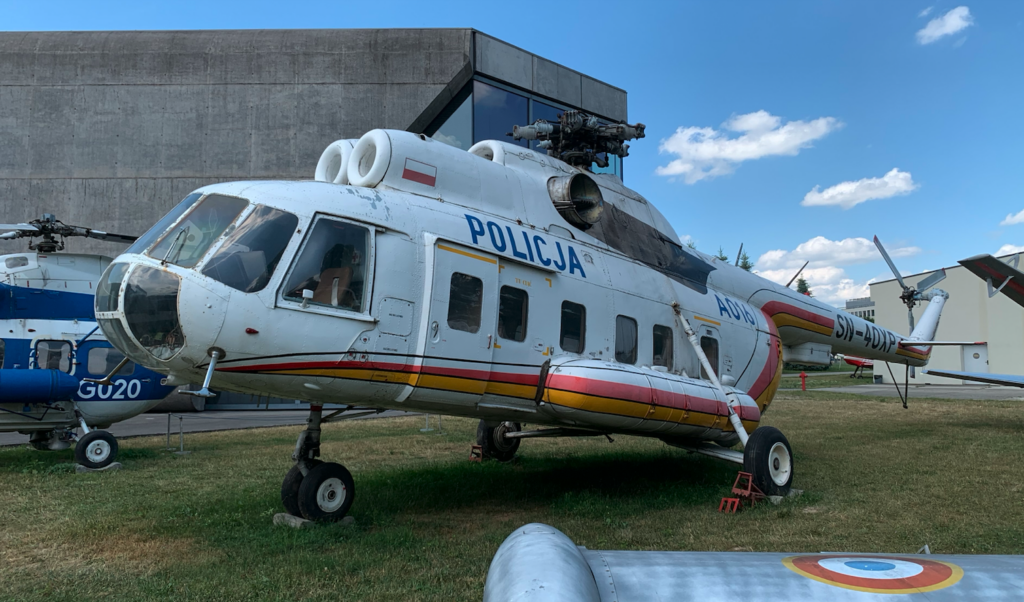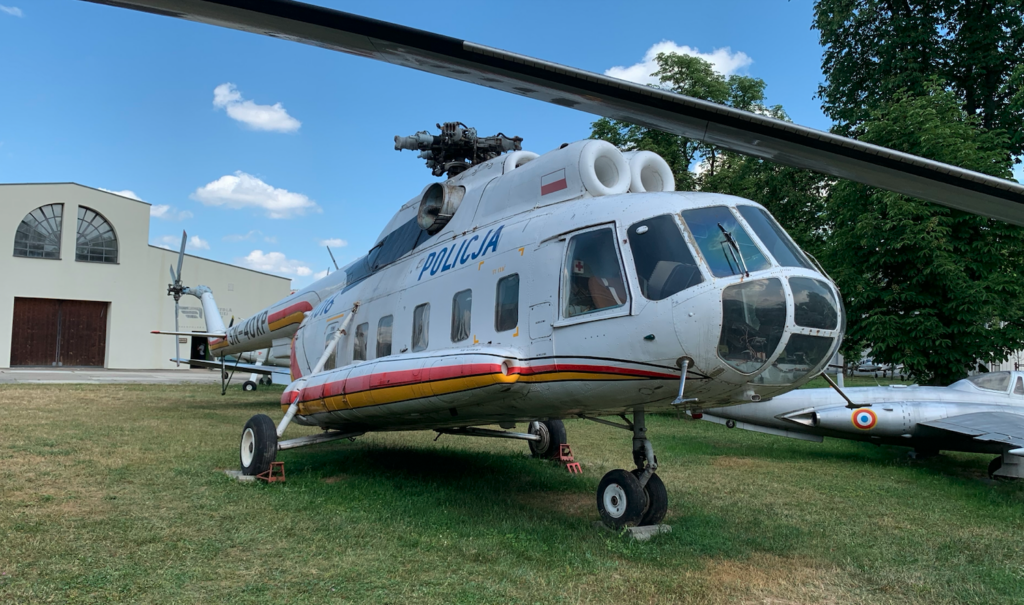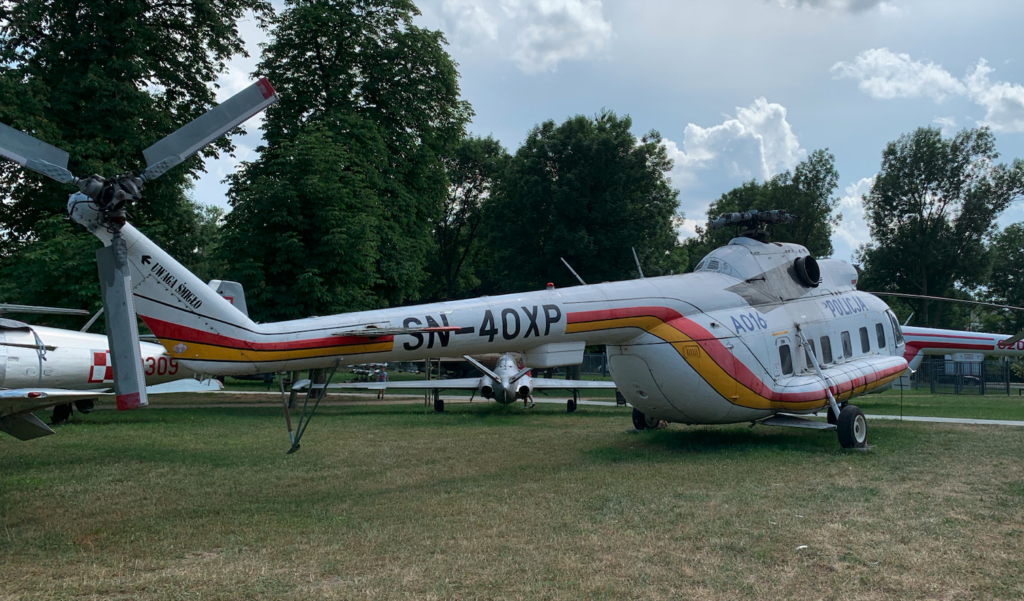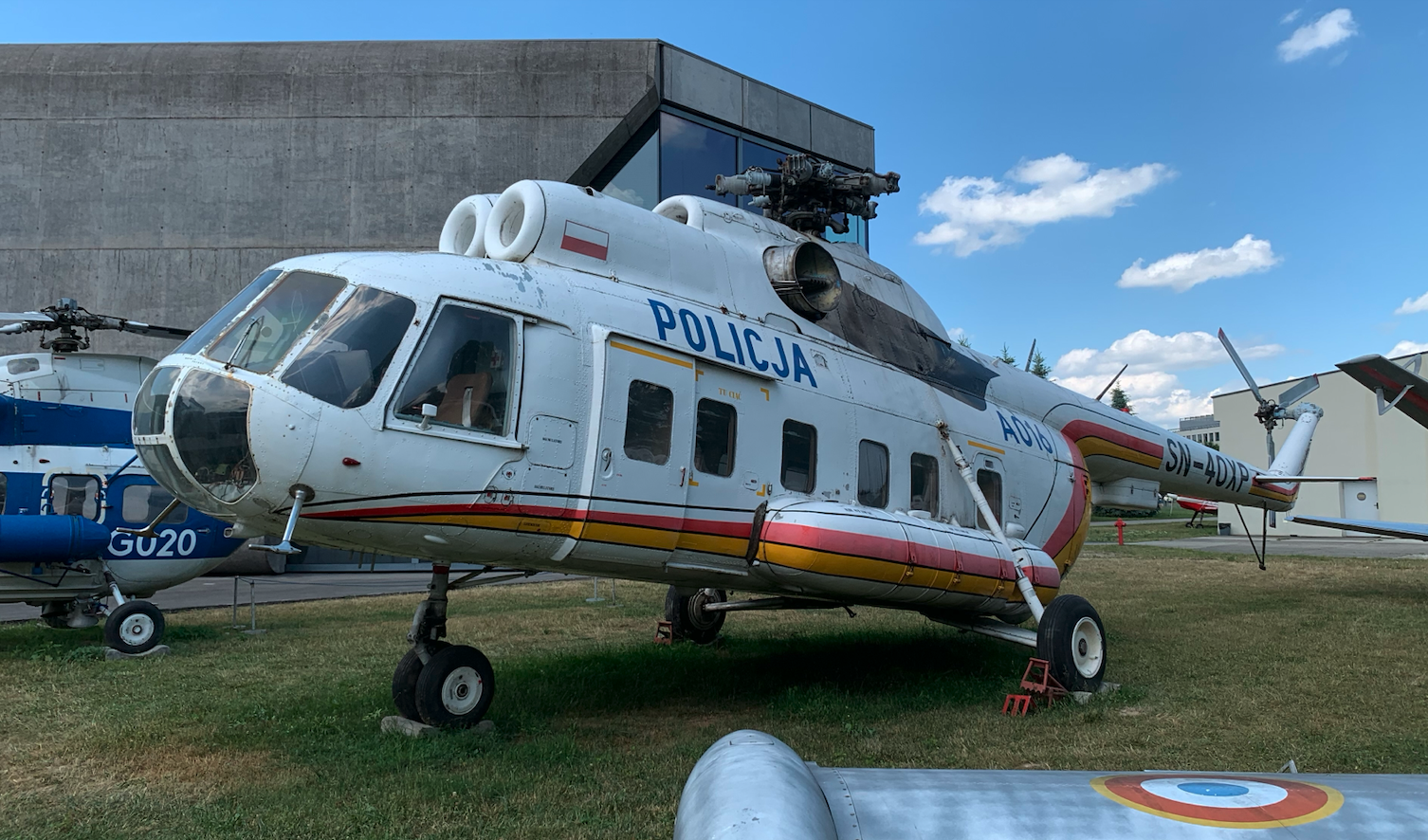Kraków 2025-02-21
Mi-8 S helicopter registration SN-40XP, A016, Serial No. 10635. 2025.



History of the Mi-8.
The Mil Mi-8 (NATO name Hip) is a medium helicopter with a drive consisting of two turbine engines. The helicopter is one of the most produced helicopters in the world. Over 12,200 machines have been built. The helicopter was and is used in 57 countries.
The reasons why Mikhail Mil in 1958 began developing the W-8 helicopter, later the Mi-8, are not fully known. Recently, on June 5, 1957, the Mi-6 helicopter was flown, which was theoretically supposed to be the successor to the Mi-4 helicopter. The Mi-6 helicopter was undergoing a wide range of flight tests. The military was satisfied with the Mil Mi-4 helicopter flown on June 3, 1952. The small Mil Mi-1 helicopter performed well. At the same time, the era of missiles on the battlefield was coming. Mikhail Mil himself was not a go-getter. In the Kremlin, he was treated as a good designer, but he was never taken for a visionary and strategist of new war technology. Mikhail Mil did not even have an independent office, and his workshop was located at the OKB-329 production plant. Sometimes the director of this plant had more to say than the designer Mikhail Mil. Mikhail Mil did not even have the title of general designer. In the literature, it is often incorrectly stated that Mikhail Mil’s office was OKB-329.
That is why the rulers in the Kremlin did not agree to start work on the new program. Presumably, Mikhail Mil was aware of the operational difficulties of the Mi-6 helicopter, whose advantage was, however, the turbine drive. Therefore, he repeated the proposal, but this time he proposed only replacing the engine with a turbine one in the Mi-4. In such a situation, the authorities agreed. Especially since they thought that it would only be an engine replacement, as was done in the West, and nothing more. The formal decision was made on February 20, 1958.
However, Mikhail Mil already had a concept for a complete reconstruction of the Mi-4. The project involved engineer Aleksandr Ivchenko, who had worked at OKB-478 in Zaporozhye, Ukraine, on an engine originally planned for aircraft. The modernized helicopter was to be equipped with a single Ivchenko AI-24V engine with an output of 1,900 hp, which was taken from the Antonov An-24 aircraft without any changes. The helicopter was to have a payload of about 2,000 kg. The engineer responsible for the new design was initially G. V. Remezov, and later V. A. Nikiforov.
The 1:1 scale model of the W-8 helicopter was completed at the end of 1958 and approved by the commission. The prototype of the W-8 helicopter had a fixed four-point landing gear, very similar to that of the Mi-4. However, during the construction of the prototype, a change was made to a three-point landing gear with a front leg equipped with double wheels. The entire program was delayed compared to the plan. The main reason was the difficulties in coordinating the work of various entities. Therefore, it was decided to use a larger number of old components, without waiting for the production of new ones. For example, the entire tail boom with the propeller, then still with wooden blades, was taken from the Mi-4.
The crew cockpit was innovative. It was completely different from the cockpit in the Mi-4. In the spacious, perfectly glazed cabin, there were positions for a three-person crew; two pilots, and between them, slightly behind, a flight engineer’s position. The latter was not in the Mi-4 helicopter. The cargo (passenger) cabin had dimensions of 5.34 m x 2.34 m x 1.8 m and was topped with a large side-opening door at the rear, as was the case in the Mi-4.
When designing the W-8 helicopter, there was a problem with access to the engine. In the Mi-4, access was from the ground level. In the W-8, there was no such possibility. Therefore, it was decided to use engine covers, which, when opened, create a platform for mechanics.
A helicopter was designed with one turbine engine placed up in front of the gearbox and main rotor. The gearbox and rotor were taken from the Mi-4. This situation did not satisfy the decision-makers, but ultimately justified the far-reaching interference in the helicopter’s airframe. The prototype called the W-8 was designed in 1958. It was powered by one Ivchenko AI-24V engine, which was later renamed the Solovyov.
The W-8 helicopter first flew on June 24, 1961, piloted by Boris Zemskov. Already in July 1961, the helicopter was shown at a parade in Tushino.
For the reasons we wrote about below, both W-8 helicopters were made as passenger ones. The interior was equipped with 18 individual seats in a 2 x 2 configuration with a passage in the middle. Square windows with a relatively large area were installed. In this configuration, the helicopter had a range of 450 km. In theory, the helicopter was supposed to carry 14 armed soldiers. Folding benches were provided for them along the sides of the cargo bay.
The second helicopter was completed in November 1961. The W-8 helicopters were used for factory tests. Fatigue tests were performed on them. Finally, in 1964, they were written off. It was planned to build three W-8 prototypes, but eventually the third was made as a twin-engine and designated W-8 A.
Helicopter W-8 A.
In September 1959, Tsar Nikita Khrushchev left for the USA. There, together with the US President, he traveled on the presidential helicopter S-58 and … was very impressed. When Khrushchev only returned to the CCCP, in order to save the face of communism, he immediately ordered a similar helicopter to be created so quickly that it would be ready for the visit of the US President to the CCCP. Therefore, Mikhail Mil developed a luxury version based on the Mi-4. Nikita Khrushchev personally inspected and traveled on board. Mikhail Mil took advantage of the opportunity and showed the Tsar the helicopter W-8, suggesting that it would be much better for the machine to have two engines, a new transmission and a new main rotor. And the engines should be developed from scratch, and not taken from an aircraft. Nikita Khrushchev agreed with the designer’s arguments and did not put the matter on the shelf.
Already in May 1960, Mikhail Mil received an order for a twin-engine helicopter, and Sergei Isotov’s design bureau was tasked with building turbine engines specifically for Mikhail Mil’s helicopter. Importantly, Sergei Isotov had already advanced work on a new turbine engine for the helicopter. Therefore, his work progressed relatively quickly. Two months after Sergei Isotov completed the engine design, it was installed on the third prototype of the helicopter, designated V-8 A. This prototype received two turbine engines designated Isotov TW2-117. Each of them had a power of 1,120 kW (1,500 hp). Importantly, the new engine weighed only 335 kg, and the ASz-82V piston engine weighed about 1,100 kg.
The construction of the V-8 A was possible only after the TW2-117 engines and a new gearbox were delivered. The gearbox was designated VR-8 and has a gear ratio of 62.6:1. Its main element is a three-stage, planetary gear.
The first flight, or rather hover, of the W-8 A helicopter no. 0201 was performed on August 2, 1962, by the crew of Nikolai Leshin. The full flight of the W-8 A was performed on September 17, 1962. The crew was led by test pilot Nikolai Ilyushin.
In October 1962, two helicopters (W-8 A and W-8 AP) were demonstrated to the authorities of the CCCP and the Warsaw Pact, headed by Nikita Khrushchev. The helicopters aroused great interest. Both helicopters were painted in the colors of Aeroflot, because it was to be the main user. It is important to know that Aeroflot was not an air carrier in the modern sense of the word. Aeroflot was a ministry. It, in the CCCP, owned all civilian aircraft and helicopters, civilian airports and the entire infrastructure. It transported not only passengers and goods, but also participated in: agricultural aviation activities, searches for natural resources, scientific expeditions, planning the location of railways, roads, power lines and future factories. Factory tests of the W-8 A soon began, which were completed in February 1963.
The fourth prototype of the helicopter, designated as the W-8 AP, was made as a luxury helicopter for VIP transport. A significant change was the installation of a new main rotor, equipped with 5 blades instead of 4 blades. The rotor was modeled on the one in the Mi-6 helicopter. The replacement of the rotor from 4 to 5 blades was dictated by the desire to reduce vibrations in the structure. The tail rotor was changed, from metal and wood to metal, steel and aluminum. At the same time, the de-icing system was changed from spirit-based (spirit was released from small holes on the leading edge of the blade) to electric. Another change was the use of wide side sliding doors to the cargo hold. As standard, helicopters intended for Aeroflot had fairings mounted on the landing gear wheels, just like the Mi-4 and Mi-6 helicopters. In the W-8A helicopter, fairings were also installed on the landing gear legs. The fifth prototype, designated as W-8 AP2, was also a passenger version, but intended for mass production for Aeroflot.
The sixth prototype, designated as W-8 AT, was a military, transport version, with the final designation Mi-8 T.
State tests were completed in November 1964, and at the same time a decision was made to start mass production. The helicopter received the official designation Mi-8. Production began at the Kazan Production Plant, previously Plant No. 387, and the first helicopters were completed at the end of 1965. Getting ahead of the facts, we will add that helicopter production was also undertaken at the Ulan-Ude Aviation Plant, previously called Plant No. 99. Currently (2018), these plants compete with each other.
The first Mi-8 helicopters did not have an autopilot installed. Later, a three-channel autopilot was introduced, as was the case with the Mi-6 helicopter. However, it was not a successful autopilot. Only the introduction of the four-channel AP-34 autopilot solved the problem of further flights.
In January 1966, one of the Mi-8 helicopter prototypes was lost. The tail rotor failed and the machine crashed to the ground in an uncontrolled descent. The entire three-person crew died.
The Mil Mi-8S (Salon) is a comfortably furnished version of the helicopter, based on the Mi-8P version with couches and a table. The prototype of this version was designated W-8AP. Its construction was completed in May 1964. Serial production began in 1969. Mi-8S helicopters were offered in 7-, 9- and 11-seater variants. It was also possible to order a 6-seater variant with an extended range. Most helicopters were powered by TW2-117F engines, with a take-off power of 1250 kW.
Mi-8 helicopters in Poland.
The first Mil Mi-8 helicopters were purchased for the Polish Army in 1967. They were purchased for military tasks for rapid response units. They were to quickly deliver assault platoons with medium-caliber weapons to combat locations. Then, these helicopters were to support the army from the air. And finally, they were to evacuate the wounded from the battlefield and entire units in the event of an attack failure. First, four Mil Mi-8 T helicopters (transport version) were purchased, which were introduced into service in 1967 and 1968.
Since 1951, the 13th Fighter Aviation Regiment operated at the Leźnica Wielka Airport in Łęczyca. Already in 1967, it was decided to create a squadron of transport helicopters at this unit. The helicopters in stock included Mil Mi-1, PZL SM-1, PZL SM-2, Mil Mi-4. On July 13, 1967, the first Mi-8 T helicopter No. 0614, Nb 614, was accepted. Subsequent helicopters: Mi-8 T No. 0314, Nb 314, introduced on August 31, 1967, Mi-8 T No. 0414, Nb 414, introduced on September 30, 1967, Mi-8 T No. 0523, Nb 523, introduced on July 26, 1968.
Almost simultaneously, another version of the Mi-8 helicopter was accepted, designed for passenger transport, which has the designation Mi-8 PS No. 0720, Nb 720, introduced on June 17, 1968. The helicopter had 28 seats in rows of four with a passage in the middle. Thus, the Transport Helicopter Squadron had four Mi-8 T helicopters and one Mi-8 PS helicopter. In the Polish Army, the helicopters were commonly called “Windmills”. In turn, the Mil Mi-8 helicopter was called “Eight”.
Due to further purchases of helicopters (windmills), it was decided to disband the 13th Fighter Aviation Regiment and form a Transport Helicopter Regiment in its place. This officially happened on December 30, 1971. In 1971, the fighter aircraft were transferred to the 1st Fighter Aviation Regiment in Mińsk Mazowiecki and to the 39th Fighter Aviation Regiment in Mierzęcice. The Transport Helicopter Squadron was transformed into the 37th Transport Helicopter Regiment, as JW 3214. A large part of the personnel remained in the new unit. The staff of the new 37th Regiment, No. 20/112, provided for 778 soldiers and 31 civilian employees. On October 12, 1972, the Regiment received its banner. The 1st Light Cavalry Regiment was formed on the basis of the 37th Transport Helicopter Regiment, which was part of the 25th Air Cavalry Division. The regiment operated until 1994, when it was transformed into the 1st Air Squadron.
In the period 1971-1973, another 21 Mil Mi-8 machines were delivered to Poland. Among them were three Mi-8 PS machines, and the rest were Mi-8 T machines. In 1977, a flight of Mi-8 PS helicopters, i.e. all machines for transporting people, arrived from the 37th Transport Helicopter Regiment to the 36th Special Transport Aviation Regiment in Warsaw. The machines performed dispatch flights for the General Staff and party VIPs.
More Mi-8 helicopters were delivered to the Polish Army in the period 1977-1983. There were 28 machines in total. In 1977, first there were three Mi-8 PS helicopters, which were eventually entered into the inventory of the 36th SPLTr., and one into the inventory of the 103rd MSW Regiment (Ministry of Internal Affairs).
Also in 1977, the Polish Army received four Mi-8 PPD machines. This is an air command version specially developed for the Polish Army based on the Mi-8 T helicopter. The helicopters received special equipment. All of these helicopters were accepted into the inventory of the 37th PŚT in Łęczyca. After the dissolution of the UW in 1989, the special equipment was dismantled from them.
In 1976, further revolts of Polish society broke out in Poland. The bloodiest was in Radom. The communist authorities were unable to manage the national economy, which was manifested in a permanent crisis. In 1976, the authorities introduced food coupons and other essential consumer goods. The public no longer bought propaganda reports about the Katowice Steelworks. The communists felt that the rebellions would intensify. Therefore, it was decided to significantly strengthen the forces of the Ministry of Internal Affairs. As many as 21 Mi-8 T helicopters were accepted for the 103rd MSW Regiment. The largest deliveries took place in the period 1978-1981. During the same period, the Polish Army did not receive a single Mi-8 helicopter. (Here is an explanation – the communists did not trust the Polish Army, because its strength was the conscript, i.e. the ordinary citizen. In the MSW they were “our own”.). After the liquidation of the 103rd MSW Regiment, the helicopters were transferred to the 1st Aviation Squadron. After another reorganization of the military structures in Poland, three Mi-8 S helicopters were transferred to the Police structures. The helicopters received registration marks; SN-40XP, SN-41XP, SN-42XP. The helicopters were designed to carry 22 passengers, with a crew of 3. The helicopters were used as transport, rescue, search and anti-terrorist machines. In 2024, two Mil Mi-8 helicopters were still in service with the Polish Police.
Mi-8 S helicopter registration SN-40XP, A016, Serial number 10635; it stood on the slope of Warsaw Babice airport for several years. In 2024, the helicopter was transferred as an exhibit to the Polish Aviation Museum in Krakow.
Written by Karol Placha Hetman

